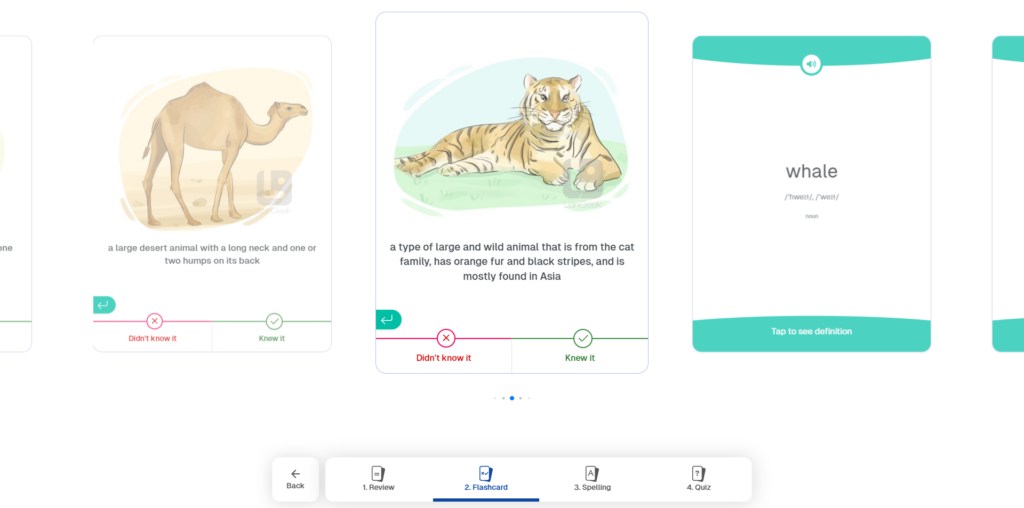The flashcards are the second step of the Langeek four-step vocabulary learning system. This step focuses on reinforcing memory by repeatedly testing the learner’s recall ability, a crucial phase for transferring knowledge from short-term to long-term memory.
Flashcards: An Overview
Flashcards are a versatile and effective learning tool that consist of a question or prompt on one side and the corresponding answer on the other. They are widely used in education for a variety of subjects, from vocabulary and language learning to science and history.
Benefits of Flashcards:
- Active Recall: Flashcards encourage active recall, a process where learners actively stimulate their memory during the learning process, rather than passively reading or listening to information. This strengthens neural connections and improves memory retention.
- Spaced Repetition: Flashcards can be used in spaced repetition systems, where cards are reviewed at increasing intervals. This technique leverages the spacing effect, which shows that information is more effectively memorized when study sessions are spaced out over time.
- Portability: Flashcards, especially digital ones, can be easily carried and reviewed anywhere, making it convenient to study in short bursts throughout the day.
- Customization: Learners can tailor flashcards to their specific needs, focusing on areas where they need the most practice. This personalized approach enhances the efficiency of study sessions.
How Langeek Flashcards Work

- Focused Learning: The flashcards only display the word’s meaning, emphasizing the core aspect of vocabulary acquisition. By concentrating on the meaning, learners solidify their understanding of each word.
- Testing Recall:
- Prompt: Learners see the word on one side of the flashcard and try to recall its meaning.
- Check: They then flip the card to reveal the meaning and confirm if they remembered it correctly.
- Repetition: If the meaning is not remembered, the card goes back into the rotation for another attempt.
- Tracking Performance: The platform tracks how often each word is forgotten. Words that are frequently forgotten are flagged for additional practice, either through a longer-term learning method like the Leitner system or a custom wordlist.
Integrating Flashcards After Word Review
Placing the flashcards step after the initial word review has several advantages:
- Reinforcement of Learning: The word review section provides a comprehensive understanding of the word, including its meaning, pronunciation, spelling, usage, and grammatical features. Following this with flashcards reinforces this newly acquired knowledge through active recall, aiding in the consolidation of information.
- Transition to Long-Term Memory: The repeated testing and recall required by flashcards help move information from short-term to long-term memory. This transition is crucial for lasting retention and ensures that learners can recall the words when needed in real-life situations.
- Immediate Feedback: The flip-and-check method of flashcards offers immediate feedback, which is essential for effective learning. This immediate correction helps learners adjust their understanding and reinforces correct information.
- Identifying Difficult Words: By tracking which words are frequently forgotten, the system identifies areas that require more focused attention. This targeted practice ensures that learners spend more time on challenging words, improving overall retention.
FAQs
No it does no currently give you the option to shuffle cards while using flashcards.
